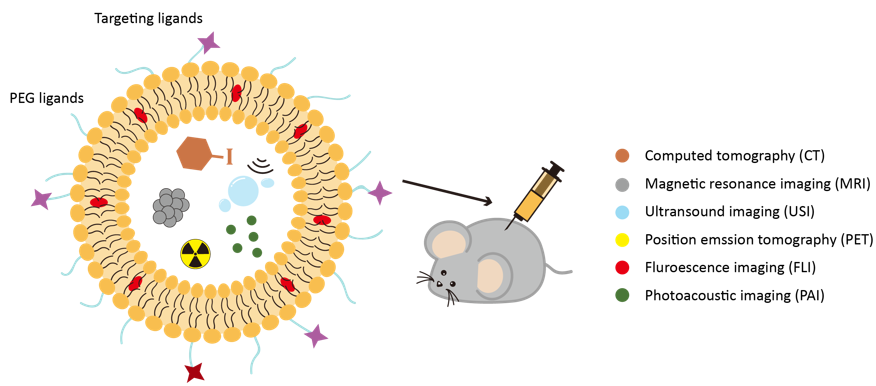Liposomes are ideal carriers of probes for molecular imaging and tracking in vivo. Surface modification of liposomes with a diameter around 100nm can greatly increase the blood circulation time of loaded probes and achieve tissue accumulation through passive & active targeting. Most probes such as hydrophobic or hydrophilic molecules, nanoparticles can be loaded by the liposome. Creative Biolabs provides full set of liposome-based imaging probes solutions for the best benefit of your research.
As an excellent drug carrier with high biocompatibility and encapsulation ability, liposomes are used to deliver not only active pharmaceutical ingredients but also molecules or nanoparticles for imaging and tracking. The incorporation of liposomes can help improve the bio-distribution and circulating time of imaging probes, providing a general way for in vivo applications.
Molecular imaging plays an important role in disease diagnosis and prognosis, and thus, imaging liposomes are widely used in imagine-guided drug delivery and disease diagnosis. Computed tomography (CT) has high spatial resolution but low sensitivity, so it is hard to imagine when the contrast between the target tissue and normal tissue is small. Therefore, CT agents such as liposomal iodine are used for the detection of bold diseases and tiny tumors. Chelates of gadolinium and iron oxide nanoparticles are commonly used as intravenous contrast agents for magnetic resonance imaging (MRI), both of which can also be loaded into liposomes to increase blood circulation and tissue targeting. Similarly, ultrasound imaging (USI) also needs contrast agents for small tumor tissue imaging. Liposomes are excellent candidates for gaseous bubbles encapsulation to increase the echogenicity of blood, and thus USI probes are generally bubble-loaded liposomes. Additionally, imaging liposomes are also widely used in positron emission tomography (PET), fluorescence imaging (FLI), and photoacoustic imaging (PAI) for targeted accumulation or real-time imaging & tracking.
 Fig 1. Different liposome-based probes for molecular imaging
Fig 1. Different liposome-based probes for molecular imaging
Imaging liposomes are prepared through common methods such as thin-film hydration, reverse-phase evaporation, and microfluidics technology, followed by sonication or extrusion to reduce them to an appropriate size. The probes are loaded through passive loading or active loading according to the structure and physicochemical properties to achieve a higher encapsulation efficiency.
The thin-film hydration method is a common passive loading strategy for both hydrophobic and hydrophilic probes. The difference is hydrophobic probes such as IR780, oleic acid-coated iron oxide NPs are added to the organic solution of lipids before liposome formulation, while the hydrophilic probes such as ICG, AuNPs, quantum dots, and large nanoparticles are dissolved into the aqueous buffer for the hydration of dry lipid membrane to form liposomes. Active loading is applicable for limited probes with a high encapsulation efficiency of 90%. To actively load probes into the liposomes, hydrophobic chelators are first incorporated into liposomes by passive loading. Then the chelator liposomes are mixed with the probe solution. The probes are finally absorbed into the liposomes under the strong interaction between the chelator and the probe.
Creative Biolabs has years of experience in liposomes design and preparation. Our professional expert team could provide fully customized imaging liposomes development service for the best benefit of your project. In addition to the conventional imaging liposomes mentioned above, we can also provide liposome products for multimodal imaging, targeting, or therapeutic effects. Contact us with your ideas and we are ready to challenge the perfect solution for you.
 For Research Use Only. Not For Clinical Use
For Research Use Only. Not For Clinical UseServices
Online Inquiry

